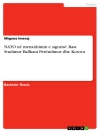This book provides a critical account of federal asymmetry in India – its origins, context, forms and functioning – by taking into account the institutional effectiveness of asymmetric institutions in the regions for identity fulfillment, development and governance. It argues that while some asymmetry, de jure/ or de facto, is part of all federations for meeting some special circumstances, in India, which has followed a different path of federation building, asymmetric institutional solutions especially in the border areas have played a crucially important role in accommodating ethno-cultural diversity, ensuring law and order, a level of development and governance in a process that has turned the ‘rebels into stakeholders’. India’s federal asymmetric designs and their working has been a key to holding the peripheries within the Union of India. The book utilizes both archival research and empirical survey data, as well as elite interviews.
Table of Content
Introduction: a Revised Template of Federalism; Theory and Concepts; Methodology; Chapterisation.- Chapter 1 Concept of Asymmetric Federalism and the Politics of Recognition— Introduction; Theoretical Framework of Asymmetric Federalism; Exclusion/Inclusion in Federalism.- Chapter 2 Founding Moment (1946-56): Introduction; Princely States: asymmetric Integration; SRC’s asymmetric approach to state-making; CA and the Making of asymmetric provision for tribal self-governance.- chapter 3. Federal Asymmetry in India and Various Forms—Introduction; State level asymmetry.- Chapter 4 Politics of Fiscal Asymmetry in India: Introduction; Finance Commission and Fiscal Asymmetry; Special Category States.- Chapter 5 Ethnic Cleavages and Federal Asymmetry: introduction; Demographics: ethnicity and diversity; demand for more.- Chapter 6 The Making and Unmaking of the Special Category States in India: introduction; SCS as federal asymmetry; SCS: development and governance.- Chapter 7 Asymmetry within Asymmetry in India: Introduction; 5th Schedule;6th Schedule; ethnic cleavages and tribal autonomous councils.- Chapter 8 The Working of Sub-State federal asymmetry in Tripura: Introduction; A brief history; Formation of the ADC; Activates of the ADC; institutionalization, development and delivery; governmental performance of the ADC; implications for governance; governmental cost of self-government.- Chapter 9 Bodoland Territorial Autonomous Districts in Assam: introduction; a short trajectory of Bodoland movement; The case of Bodoland: whose homeland; Bodo ethnic peace accords for power-sharing and legitimacy; from BAC to BTC: half-hearted institutionalization.- Chapter 10 A Comparative Assessment of Asymmetric Federalism in India: introduction; a brief macro history; comparative practices; contentious territory claims; making of a political region; limited federalism.- Conclusion: Summary of Findings and Evaluation.
About the author
Harihar Bhattacharyya is Professor in the Department of Political Science at the University of Burdwan, India. He holds a Ph D in Government from the London School of Economics and Political Science. He taught at the South Asia Institute a the University of Heidelberg, Germany, Hull University, UK, Institute of Federalism, Fribourg, and Delhi University, India.












